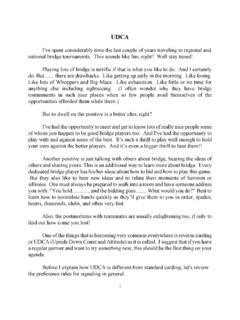Transcription of Odd/Even Discards What are Odd/Even (O/E ... - Omaha Bridge
1 1 Odd/Even Discards (Good or Bad?) What are Odd/Even (O/E) Discards ? also called roman Discards , they are a discarding method whereby the first card that you discard is an attempt to signal partner as to which suit you d like led. Are they more advantageous to the defense or to the is the question? first let s define some terms. To discard means to fail to follow to the suit that declarer had led thus playing a card from another suit but not a trump. discarding as a the term also applies not only to the order in which you play other suits when failing to follow suit but also to which cards are kept for later play. The art of discarding is a fundamental aspect of the game. Signaling is an attempt to communicate with partner when defending by (1) the order in which you play your cards when following suit, and (2) the cards you play as well as the order in which you play them when not following suit (or discarding ).
2 There are several methods of signaling, but the ACBL does not allow dual-message carding except on defender s first discard . Thus O/E signals (as opposed to O/E Discards ) and encrypted signals are the reasoning being that they are inconsistent with playing in tempo. O/E or roman Discards work like this; at your first opportunity to discard , the card you play sends one of the following messages: (1) an odd discard encourages the suit being discarded (2) an even discard discourages the suit being discarded (3) a high even card (since it discourages the suit being discarded) suggests a shift to the high-ranking suit (4) a low even card (since it also discourages the suit being discarded) suggests a shift to the lower-ranking suit Quite obviously the trump suit is excluded, but some day someone will come up with a good method of discarding that asks for partner to lead a trump.
3 The following is an example of how it it also portrays exactly why I don t like it. 2 North AQ5 32 KQ63 AT74 West East Contract 3NT 732 KJ86 Opening Lead: 4 KT54 A876 T4 982 Q652 83 South T94 QJ9 AJ75 KJ9 West led the 4 won by the Ace. The 6 was returned to the King and West exited with a third heart. South now played off four rounds of diamonds. On the third diamond West s O/E pitch of the 2 showed no interest in spades but suggested clubs.
4 On the fourth diamond East s O/E pitch of the 8 said that East didn t like clubs but did like spades. These O/E Discards gave away the whole hand. Declarer now knew how to play the clubs and knew to refuse to take any spade finesses. I have seen defenders agonize over which card to discard in order to make an O/E signal when it was known that they had several cards from some worthless long suit that could be used for suit preference signals. Another example: North Contract 6 K9643 Opening Lead 10 Q984 Dlr: North AQ AQ West East J75 82 1062 A K10753 J842 95 K107632 3 South AQT KJ753 96 J84 In this example, the obvious problem is whether to take the club finesse or the diamond finesse.
5 If East s first pitch is the 3, doesn t that increase the odds that you will take the right finesse? On this particular hand it s hard for East to falsecard because there are only even cards in the diamond suit. Incidentally, if East had the opportunity to double cuebids of both clubs and diamonds and didn t, it may affect declarer s play. However, it seems that a double of a club cuebid to suggest a club lead have been better than using an O/E discard during the play of the hand? So what s a better method of carding? My suggestion is this: Playing standard carding: (RC = Remaining Count, SP = Suit Preference) Partner Leads Declarer Leads Discards1st Hi=Enc, Lo=Disc Start of Std count* Attitude (Hi=Enc., Lo=Disc.) 2nd RC or SP RC or SP RC or Lo=Disc. 3rd SP SP SP * Smith Echo vs NoTrump Or Playing UDCA: (RC = Remaining Count, SP = Suit Preference) Partner Leads Declarer Leads Discards1st Hi=Disc, Lo=Enc Start of UD count** Attitude (Hi=Disc.)
6 , Lo=Enc) 2nd RC or SP RC or SP RC or Hi=Disc. 3rd SP SP SP ** Reverse Smith Echo versus NoTrump Undoubtedly I m going to hear about the good side of O/E Discards via email or whatever. So be it. Marilyn Hemenway October 2006


